Repetitive Motion Injuries in the Workplace: 5 Things to Know
Posted November 17th, 2016 by Anthony Carbone, PC.
Categories: Workers Compensation.
 Does your job require some type of repetitive motion? Has it caused you to suffer severe injuries? Maybe even surgery to correct or improve painful damages? If you are diagnosed with a medical condition related to repetitive motion at your workplace, you may be entitled to receive workers’ compensation benefits.
Does your job require some type of repetitive motion? Has it caused you to suffer severe injuries? Maybe even surgery to correct or improve painful damages? If you are diagnosed with a medical condition related to repetitive motion at your workplace, you may be entitled to receive workers’ compensation benefits.
It could be that your job requires repeated bending or lifting. Or, that you work on a machine that requires you to move your hands in a continuous manner. Perhaps you spend long hours entering data into a computer. It might be that you use a jackhammer on a daily basis and have suffered injuries. An experienced workers’ compensation attorney can help determine if you have a repetitive motion injury claim.
Repetitive Motion Injuries are Occupational Claims
We’ve already provided you with some information regarding occupational exposure claims. These can mean anything from exposure to chemicals, noise or dust and debris. Repetitive motion injuries fall into this same category. The injuries are cumulative, rather than restricted to a particular event. Here are some other important things to know:
- Statute of Limitations: The statute of limitations for a repetitive motion claim may start from the first day you knew or should have known the injuries were related to duties performed at work. You should notify your employer as soon as you have that knowledge so that they can arrange for authorized medical treatment.
- Examples of work-related repetitive motion activities: Here’s a list of some work-related repetitive motion activities that may cause injuries:
- Using the same hand motions on an assembly line
- Unloading trucks
- Carrying construction materials
- Entering data or stuffing envelopes
- Standing in awkward positions on hard surfaces for extended time periods
- Examples of work-related repetitive motion injuries: Some of the most common work-related repetitive motion injuries include: neck and back strains and sprains; carpal tunnel syndrome; shoulder issues, such as rotator cuff injuries; tendonitis; bursitis and spinal disc herniation. Essentially, any injuries that a doctor may attribute to repetitive motion may fall into this category.
- Repetitive motion may not have caused a new injury: Although repetitive motion can be attributable to a new condition, it can also trigger issues to a preexisting condition. If a worker proves their preexisting injuries are exacerbated as a result of repetitive motion at work, they may be entitled to workers’ compensation benefits.
- Benefits available for repetitive motion injuries: The New Jersey Workers’ Compensation Act allows for three important benefits. These include payment for authorized medical care, temporary disability checks and prospective awards for partial or total permanent disability.
Contact Us
At the Law Offices of Anthony Carbone, we have handled claims for injured workers for almost thirty years. There is no charge to speak with us. Contact us to see how we can help you in pursuit of your workers’ compensation claim.


